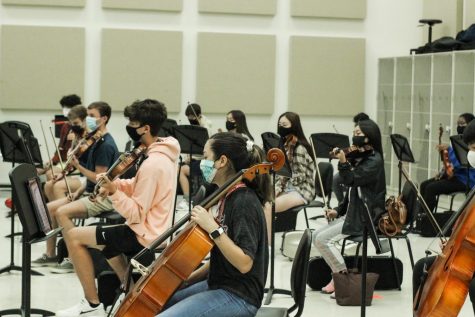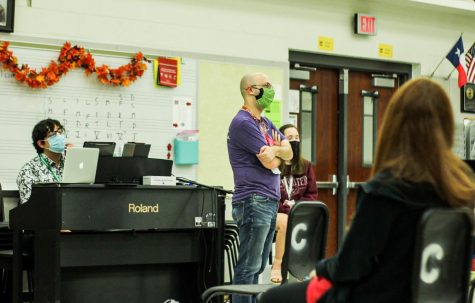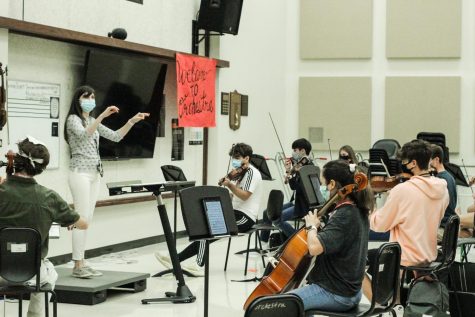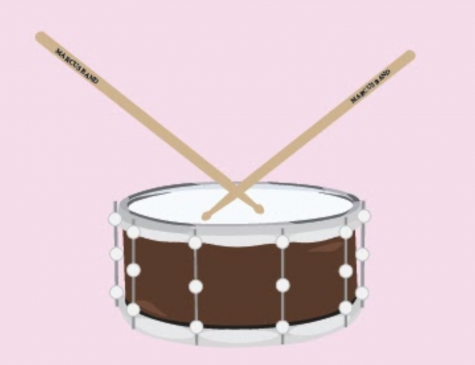Changing tune
Performing arts adapt to COVID-19
September 29, 2020

Like many other school departments, the performing arts will be making changes to their curriculum for COVID-19 to ensure student safety and productivity.
“We are doing what we can to make this a growth year and not just a ‘survive and maintain’ year,” Assistant Choir Director Drew Howard said.
This has included changing the performing arts’ rehearsals and events around COVID-19 to keep students safe while staying productive.
Choir
The biggest change that choir students are facing is the way they practice. The students spend half an hour each day in the auditorium, where chairs are spread out by six feet. They take their assigned places and sing through their masks.
Switching rooms during rehearsal is one of the precautions that the choir is taking to minimize the spread of COVID-19 through the air. Aside from the fourth period freshman women’s choir, which can sing in the choir room and let it air out before the next day, the students stay in the choir room for one hour of the period and do activities that do not require singing like humming, learning music fundamentals and sight singing.
“On pen and paper, you technically could sing in the choir room for those first 30 minutes, allow it to ventilate while you’re in the auditorium, and then come back after 30 minutes [when] the choir room is ventilated, but we don’t take that chance,” Assistant Choir Director Drew Howard said.

There are only about 30 virtual choir students, but the directors said they will make sure that they also have a chance to grow musically. The virtual students work on rhythm, sight singing and basic music fundamentals and theory. They also work on music specific to their skill set, like the in-person students do.
Choir will also be having a virtual concert. In-person students will record their performances ahead of time. Choir directors Howard and Wesley Davis plan to take these clips, along with the individual videos that virtual students send in, and put them together into a massive online concert that can be sent out. The directors are also considering streaming the concert via YouTube so it feels more like an event.
“One of our big rationales behind doing that virtual choir is it is something that allows our virtual students to participate in as well,” Howard said.
Howard said that the choir teachers are still there to help the students grow.
“Even if that growth and development is allocated a little bit differently than usual, it’s still very much there and very much present in our teaching and the learning of our students,” Howard said.
Orchestra
Like virtual choir, the virtual orchestra learns material that is specific to their musical ability. Though all of the virtual students are taught in the same period, the period is split into three 15 minute sections with one period for each of the major orchestras — Philharmonic, Sinfonia and Chamber. The students learn the music that the in-person students do, and complete playing assignments.

The orchestra has also been working on music for its fall concert. Like choir, Orchestra Director Allison Washler is planning on having students pre-record the program instead of having an in person concert, which will be available on a virtual platform.
“It’s just a great way to be able to hold a concert without having to risk anybody getting sick,” sophomore and cello player William Cleland said. “It also provides a great way for people who weren’t able to attend the concert in person to be able to [listen to] the concert later.”
The orchestra is also exploring music history and theory in class. Each week, the students read about an aspect of music theory and take a quiz on it, which gives them a chance to expand their musical knowledge.
Band
During band practice, several step markings put at least ten feet of distance between students while they march. The students wear normal masks while rehearsing their performance and put on different masks that have holes for the instruments when they need to play.
Sophomore and clarinet player Akshirtha Selvakumar believes changing masks when necessary is comforting for many band members.

“It’s kind of making them feel safer, which is a big thing that Mr. Jones and the directors have been talking about,” Selvakumar said. “Making all of us feel comfortable, no matter what our stress level is about this.”
This year’s marching band performance has been altered to minimize contact and follow the UIL social distancing guidelines. Instead of bleachers, the band will sit in folding chairs in the end zone during the game to maximize social distancing.
Rehearsals and football game performances are optional for virtual band members. Color guard and band started rehearsing together two weeks ago and performed at the football game on Sept. 25. Groups of band members also recorded themselves playing school songs for the virtual patriotic pep rally.